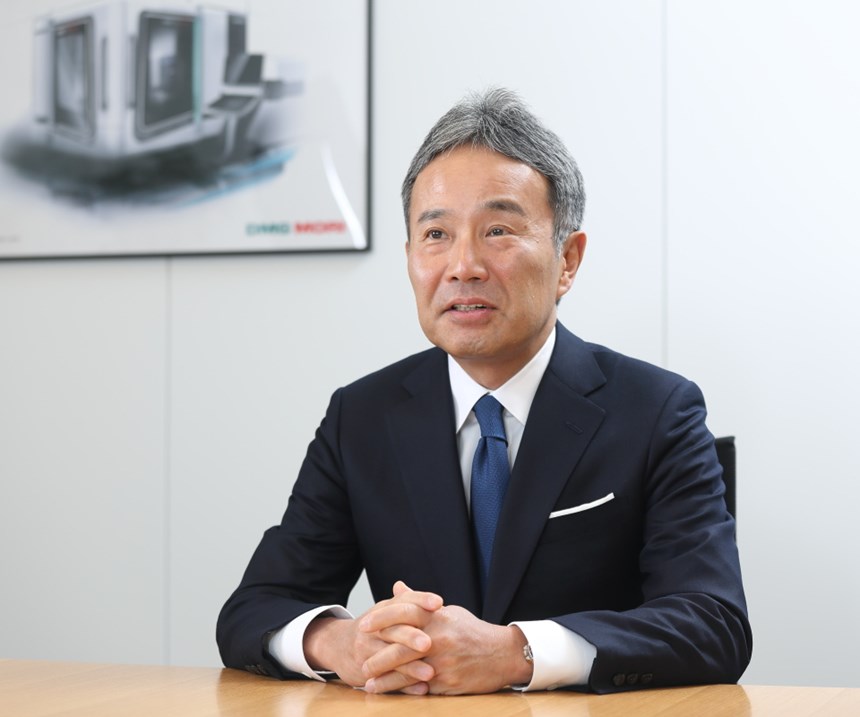Transformation of Powertrains is a Chance for Growth
We recently talked with Dr. Masahiko Mori, president of DMG MORI Co. Ltd., about what a shift towards alternative drives and changing requirements on combustion engines means for the machine tool builder’s future.
Contrary to previous studies, purely electric vehicles are forecast to account for barely more than ten percent of all passenger car fleets worldwide during the next ten years. Internal combustion engines will accordingly remain the paramount drive concept. For machine tool builders, this means that in the medium term that related metal-cutting work will tend to increase, and as time goes by, will not significantly (if at all) decrease.
Cars of the future will be radically different than the automobiles of today. When you’re ready to leave in the morning, a driverless car stops in front of your home and you hop in. It will drive you directly to wherever you tell it to go. Vehicles will be more fuel efficient, zero-emission, and use high tech electronics and software to assist drivers in a variety of ways. Vehicles will communicate with each other, with the road and with traffic signals.
According to the Energy Information Administration’s (EIA) Annual Energy Outlook of 2018 (AEO 2018), in 2016, carbon dioxide (CO2) emissions from the U.S. transportation sector exceeded emissions from the power sector for the first time since 1979. Consequently, vehicle efficiency and zero emissions are of great importance. However, while over the next 30 years sales of electric vehicles is expected to grow (electric, plug-in hybrid electric, and hybrid vehicles, are expected to jump to 19 percent of vehicle sales in 2050), conventional gasoline vehicles will continue to dominate the U.S. vehicle fleet, the EIA says.
No doubt, electrification will be the driver of the transportation sector going forward, but the pace of technology breakthroughs seems to be slower than initially anticipated. The transportation sector will largely look the same as it does today in the next ten years, which is the reason why most machine tool builders are not expecting a radical transformation of production technology.
The World Goes Electric—Machine Tool Builders Benefit
But the demands on technology (including machine tools) are changing, says Dr. Masahiko Mori, president of DMG MORI. “The combination of hybrid drives, a higher level of complexity at the internal combustion engine, rising sales figures for vehicles and the demand for lighter and more fuel-efficient engine concepts will keep the demand for machine tools up,” he says. “However, our focus is—and has been for a while—shifting towards a reduced number of machine models, towards mill-turn technology, five-axis machines and of course automation solutions.”
According to Dr. Mori, electric cars need to be lighter, requiring not only different drive concepts but also the development of new lightweight materials such as carbon fiber reinforced polymers, which need to be machined and molded. Therefore, demand for high-speed, highly-precise milling machines will grow, as well as customers’ demand for five-axis and mill-turn technology.
“Shops need to be more efficient and invest in automation in order to be globally competitive,” he says. “We might see a decline in orders for horizontal machining centers to produce cam and crankshafts because some of the combustion engines in automobiles will be replaced by electric drives. However, HMCs only make up about 10 percent of our business, which will be more than compensated by our customers’ increasing demand for high-precision mill-turn technology to produce components for electric vehicles.”
DMG MORI has been producing 90 percent of its direct motor spindles in Japan—an in-house machining expertise that will be beneficial for the company when it comes to selling highly-precise and automated machine tools to customers who produce parts for electric cars. According to Dr. Mori, a motor for EVs has similar demands on quality and precision as the ball screws and direct drives DMG MORI is already producing for its machines. The experience is there.
Moreover, the company is prepared for increasing demands on precision when it comes to manufacturing parts for electric cars due to the different noise behavior compared with fuel-driven vehicles. Omission of the combustion engine makes the vehicle extremely quiet, so that the tire rolling and the quiet humming of the electric motor are almost the only sounds heard. This change increases demands on the noise vibration harshness behavior of the vehicle. Among other things, components in the drive must work together even more quietly and be machined even more precisely.
To meet these high demands on precision, DMG MORI has been working on machine-integrated measurement solutions, Dr. Mori says, which was the “next logical step in Industry 4.0 developments and connected machining. Measurements on CMMs, for instance, are still happening outside the machine tool. It would be a great benefit to our customers to machine and measure the part (also in series production) in one setup.”
As a result, DMG MORI has partnered with Applied Automation Technologies Inc. (AAT) on the development of on-machine measuring software. The software was developed to meet the needs of so-called smart manufacturing best practices, particularly the ability to perform coordinate measuring machine (CMM) measurement and other metrology tasks. The product, CappsNC, is described as providing the capability to quickly develop measurement programs off-line and run them on CNC machine tools in a similar way to a CMM. Measurement results are used to adjust machining process parameters such as work offsets, dynamic tool compensations and other critical data feedback in an automated process, together with providing complete part inspection and SPC reports.
Read Next
Finding the Right Tools for a Turning Shop
Xcelicut is a startup shop that has grown thanks to the right machines, cutting tools, grants and other resources.
Read MoreHow To (Better) Make a Micrometer
How does an inspection equipment manufacturer organize its factory floor? Join us as we explore the continuous improvement strategies and culture shifts The L.S. Starrett Co. is implementing across the over 500,000 square feet of its Athol, Massachusetts, headquarters.
Read More

















